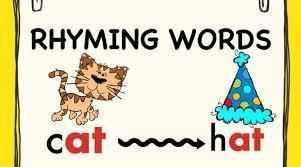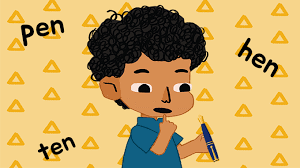Year 1 Exam > Year 1 Notes > Year 1 English IGCSE (Cambridge) > Rhythm and rhyme
Rhythm and rhyme | Year 1 English IGCSE (Cambridge) PDF Download
Introduction to Rhyming Words
Rhyming words are words that have the same middle and ending sounds. They make poems, songs, and stories more fun and enjoyable.
Examples of Rhyming Words
- Cat and Hat: Both words have the same "at" sound.
- Tree and Bee: Both words have the same "ee" sound.
- Dog and Frog: Both words have the same "og" sound.
- Cake and Snake: Both words have the same "ake" sound.
- Star and Car: Both words have the same "ar" sound.
- House and Mouse: Both words have the same "ouse" sound.
- Clock and Sock: Both words have the same "ock" sound.
- Bear and Pear: Both words have the same "ear" sound.

Tips for Learning Rhymes
- Listen to Rhymes in Songs and Poems: Songs and poems often use rhyming words. Listen carefully to the words and try to spot the rhymes.
- Practice with a Friend: Take turns saying a word and finding a rhyming word.
- Read Rhyming Books: Many children’s books use rhymes. Read them and try to recognize the rhyming words.
Question for Rhythm and rhymeTry yourself: Which of the following pairs of words rhyme?View Solution
Conclusion
Rhyming words are fun and help us play with sounds in language. Keep practicing, and soon you’ll be a rhyming expert!
The document Rhythm and rhyme | Year 1 English IGCSE (Cambridge) is a part of the Year 1 Course Year 1 English IGCSE (Cambridge).
All you need of Year 1 at this link: Year 1
|
3 videos|11 docs|5 tests
|
FAQs on Rhythm and rhyme - Year 1 English IGCSE (Cambridge)
| 1. What is the difference between rhythm and rhyme in poetry? |  |
Ans. Rhythm refers to the pattern of stressed and unstressed syllables in a line of poetry, while rhyme is the repetition of similar sounds at the end of words.
| 2. How do rhyming words enhance the overall effect of a poem? |  |
Ans. Rhyming words can create a sense of musicality and unity in a poem, making it more memorable and enjoyable for the reader.
| 3. Can you provide examples of common rhyming words in the English language? |  |
Ans. Examples of common rhyming words include: cat/hat, moon/june, sun/fun, and run/fun.
| 4. How can one improve their ability to identify rhyming words in a poem? |  |
Ans. Practice reading and listening to poetry regularly to train your ear to recognize rhymes more easily. You can also try writing your own poems with rhyming words.
| 5. Are there any rules to follow when using rhyming words in poetry? |  |
Ans. While there are no strict rules for using rhyming words in poetry, it is important to maintain consistency in rhyme scheme throughout a poem to ensure coherence and flow.
Related Searches





















